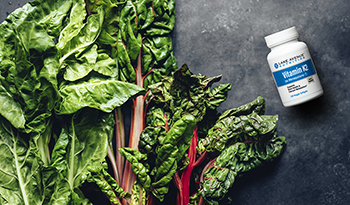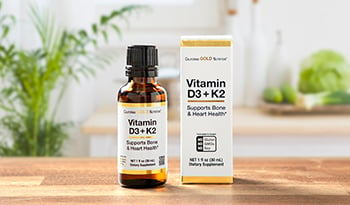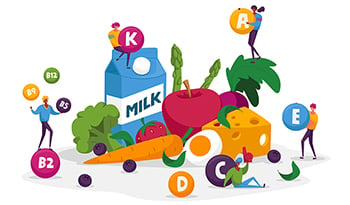How Vitamin D and K Work Together to Support Cardiovascular Health
DISCLAIMER:This blog does not intend to provide diagnosis...
- In this article:
- What Is Vitamin K?
- What Is Vitamin D?
- Cardiovascular Risk Factors
- Synergistic Effects of Vitamin K and D
- Recommended Intakes of Vitamins D and K
- Takeaway

Vitamins D and K are essential to bone health and your body's clotting mechanism. Recent studies have demonstrated a synergistic effect of both Vitamin D and K and their beneficial impact on cardiovascular health. Low levels of vitamin K and D have been associated with a greater risk of all-cause mortality compared to people with normal levels of vitamin D and K. This article will review what vitamin K and D are and how they may benefit your heart.
What Is Vitamin K?
Vitamin K is a fat-soluble vitamin present in different foods and is available as a dietary supplement. Vitamin K is involved in the process your body uses to make proteins involved in blood clotting. Some anticoagulant medications inhibit vitamin K's actions from preventing your blood from clotting.
There are two components of vitamin K: K1 and K2. Vitamin K1 is mainly found in leafy vegetables, and it is the main dietary form of vitamin K. Vitamin K2, on the other hand, is found in animal-based foods and fermented foods like cheese and yogurt. In addition, your gut's bacteria also produce some vitamin K2.
Vitamin K has shown promise in helping prevent calcification of the blood vessel wall, which is why much research has been done on how vitamin K may help prevent atherosclerosis and support cardiovascular health. Vitamin K is stored in the liver and other body tissues, including the brain, heart, and bones. Unfortunately, vitamin K is not stored completely in the body; 50% is excreted in feces and 20% in the urine, which is one of the reasons why leafy green vegetables are recommended as part of a healthy diet. In addition to other nutrients, leafy greens contain vitamins A, C, and E, iron, magnesium, potassium, and calcium, and they also are packed with carotenoids, antioxidants, and fiber.
What Is Vitamin D?
Vitamin D, also referred to as calciferol, is another fat-soluble vitamin that is present in some foods, is added to others like milk, and is available as a dietary supplement. Vitamin D is also unique in that your body makes it when you are exposed to sunlight; for this reason, it is also known as the sunshine vitamin. Vitamin D promotes calcium absorption in your bones, preventing calcium buildup in your blood. Without enough vitamin D, you may have the risk of developing brittle bones, and a deficiency can contribute to a condition called osteoporosis. In children, vitamin D prevents a condition called rickets.
There are two primary forms of vitamin D: D2 and D3. The main active form in the body is Vitamin D2. Sources of vitamin D include salmon, trout, tuna, and fish oils. Other foods containing vitamin D include mushrooms and egg yolks. Some foods are fortified to contain vitamin D, including milk, margarine, cheese, ice cream, and plant milk alternatives from soy, almonds, or oats. Finally, your body can make its own vitamin D: you need sun exposure. The time of day, clouds, smog, and skin melanin content contribute to the amount of sunlight absorbed. Of note, protecting yourself from excess UV light exposure is important due to the risk of developing serious skin conditions. Applying sunscreen can help protect your skin, but it will also prevent you from absorbing UV light to make vitamin D, which is why many foods are fortified and why supplementing with vitamin D is recommended.
Cardiovascular Risk Factors
According to the World Health Organization (WHO), cardiovascular diseases have become the leading cause of death globally, with an estimated 17.9 million people dying from CVD (cardiovascular disease) in 2019. Cardiovascular diseases include:
- Coronary heart disease is a disease of the blood vessels that supply blood to the heart, leading to heart attacks.
- Cerebrovascular disease is a disease of the blood vessels that supply the brain, leading to strokes.
- Peripheral arterial disease is a disease of the blood vessels in the arms and legs.
Heart attacks and strokes are due to blockage of blood flow to the heart or brain, usually due to the buildup of fatty acids in the walls of the blood vessels that supply the heart and brain. The key to cardiovascular disease is that most can be prevented by lifestyle modifications and changing risk factors associated with cardiovascular disease like smoking tobacco, obesity, unhealthy diet, lack of physical activity, and excess alcohol use.
The most critical risk factor you can modify to prevent cardiovascular disease is an unhealthy diet and stopping tobacco use. Reducing salty processed foods, not using tobacco products, and limiting alcohol consumption may help prevent cardiovascular diseases. Eating a diet filled with fruit and vegetables and engaging in regular physical activity—at least 30 minutes per day—are two behaviors you can adopt to help protect yourself from cardiovascular disease.
Synergistic Effects of Vitamin K and D
According to the Journal of Nutrition, there is a suggested synergistic effect of vitamin D and K on cardiovascular health. Low concentrations of these vitamins have been associated with high blood pressure and increased thickness of the arterial walls. Vitamin D has been shown to stimulate the production of proteins that depend on vitamin K. Although you can supplement with Vitamin D or Vitamin K independently, vitamin K and D may have a combined superior effect when taken together.
Dal Canto et al. studied 601 individuals 70 years and older and found that the participants with low levels of vitamin D and vitamin K had higher BMIs, higher prevalence of chronic conditions like type 2 diabetes, and high blood pressure compared with those who had normal levels of these vitamins. In addition, participants with low levels of vitamin D and K had higher rates of using heart disease medications. Finally, of the 601 participants studied, 321 participants with chronic conditions like high blood pressure also demonstrated changes to the structure of their heart muscle, and these individuals also had low levels of vitamin D and K.
In the VINDICATE study (Effects of Vitamin D on Cardiac Function in Patients with Chronic Heart Failure), high-dose supplementation with vitamin D, about 4,000 International Units (IU) was associated with improvement in cardiac function, meaning the heart pumped better when supplementing with high doses of vitamin D. Women (but not men) who had higher levels of vitamin K had improvement in their left ventricular mass index, which indicates how large the heart is and how much the heart is working due to high blood pressure.
Recommended Intakes of Vitamins D and K
In addition to having a diet filled with leafy greens, if you are interested in increasing your vitamin K intake, many multivitamin supplements contain about 75% of vitamin K's daily value. Other dietary supplements contain only vitamin K as well but may be combined with other nutrients such as calcium, magnesium, or vitamin D. The recommended daily intake of vitamin K is 120 micrograms (mcg) and 90 mcg for men and women, respectively. Before supplementing with vitamin K, speak with your healthcare provider because vitamin K can interact with other medications, especially if you are taking medicines to help prevent clotting.
In addition to eating fish and milk and making vitamin D after being out in the sun, you can supplement with vitamin D found in multivitamins, as a supplement by itself, or with calcium. Vitamin D is measured in micrograms and International Units, where one mcg equals 40 IU. The recommended daily allowances for adults up to 70 years of age are 600 IU or 15 mcg, and the recommended daily allowance is 800 IU for people 70 years or older. Many professional societies recommend higher intakes, with the Endocrine Society recommending that adults take 1,500–2,000 IU daily.
Takeaway
One of the contributors to living a long healthy life is protecting your cardiovascular health. As mentioned by the WHO, many cardiovascular disease risk factors are modifiable. With the help of vitamin K and D, you can also help protect your cardiovascular health. Before starting any new supplement, consult your healthcare provider to see if you are taking any medications that will counteract dietary supplements. And remember—a healthy diet filled with leafy greens and vegetables can prevent serious cardiovascular conditions and help you live a long, healthy, and happy life.
References:
- Beulens JW, Dal Canto E, Stehouwer CD, Rennenberg RJ, Elders PJ, van Ballegooijen AJ. High vitamin K status is prospectively associated with decreased left ventricular mass in women: The Hoorn study. Nutr J. 2021;20(1). doi:10.1186/s12937-021-00742-0
- Cardiovascular diseases (CVD). World Health Organization. Accessed June 20, 2022. https://www.who.int/news-room/fact-sheets/detail/cardiovascular-diseases-(cvds)
- Dal Canto E, Beulens JW, Elders P, et al. The Association of Vitamin D and vitamin K status with subclinical measures of cardiovascular health and all-cause mortality in older adults: The Hoorn Study. J Nutr. 2020;150(12):3171-3179. DOI: 10.1093/jn/nxaa293
- Just right: How much vitamin D is enough? Endocrine News. Published September 1, 2015. Accessed June 20, 2022. https://endocrinenews.endocrine.org/nov-2014-just-right-how-much-vitamin-d-is-enough/
- Office of dietary supplements - vitamin D. NIH Office of Dietary Supplements. Accessed June 21, 2022. https://ods.od.nih.gov/factsheets/VitaminD-HealthProfessional/.
- Office of dietary supplements - vitamin K. NIH Office of Dietary Supplements. Accessed June 21, 2022. https://ods.od.nih.gov/factsheets/VitaminK-HealthProfessional/.
- van Ballegooijen AJ, Beulens JW, Kieneker LM, et al. Combined low vitamin D and K status amplifies mortality risk: A prospective study. Eur J Nutr. 2020;60(3):1645-1654. doi:10.1007/s00394-020-02352-8
- Witte KK, Byrom R, Gierula J, et al. Effects of vitamin D on cardiac function in patients with chronic HF – The VINDICATE Study. J Am Coll Cardiol. 2016;67(22):2593-2603. DOI: 10.1016/j.jacc.2016.03.508
- Yan L. Dark Green Leafy Vegetables. Dark Green Leafy Vegetables: USDA ars. Published August 13, 2016. Accessed June 20, 2022. https://www.ars.usda.gov/plains-area/gfnd/gfhnrc/docs/news-2013/dark-green-leafy-vegetables/

 By Dr. Gabriel Espinoza, M.D.
By Dr. Gabriel Espinoza, M.D.


